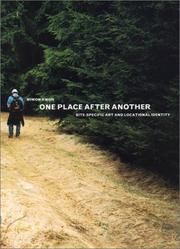| Listing 1 - 2 of 2 |
Sort by
|
Book
ISBN: 9463723765 9048554543 Year: 2022 Publisher: Amsterdam University Press
Abstract | Keywords | Export | Availability | Bookmark
 Loading...
Loading...Choose an application
- Reference Manager
- EndNote
- RefWorks (Direct export to RefWorks)
Site-specific installations are created for a specific location and are usually intended as temporary artworks. The Perpetuation of Site-Specific Installation Artworks in Museums. Staging Contemporary Art shows that these artworks consist of more than a singular manifestation and that their lifespan is often extended. This book provides an in-depth account of the paradoxical situation when site-specific installations are being preserved and put on display in a museum context. Tatja Scholte offers a conceptual framework for scholars and professionals in order to better understand the transformative nature of site-specific installation art and to support decision-making in museums as to conserving and presenting these artworks over time. The case studies provide insight into the diversity of artistic production over the last forty years. They explore how site-specific installations gain new meanings and forms in a museum context, and, vice versa, how these artworks become agents for change of professional routines and museum strategies.
Installations (Art). --- Site-specific art. --- ART / Collections, Catalogs, Exhibitions / Permanent Collections. --- Site-specific installation, museum, conservation, exhibition, spatial theory. --- Installation art --- Art, Modern --- Environment (Art) --- Site art --- Site-specific arts --- Arts, Modern --- Installations (Art)

ISBN: 0262277808 142372996X 9780262277808 0262112655 9780262112659 026261202X 9780262612029 Year: 2002 Publisher: Cambridge, Mass. MIT Press
Abstract | Keywords | Export | Availability | Bookmark
 Loading...
Loading...Choose an application
- Reference Manager
- EndNote
- RefWorks (Direct export to RefWorks)
A critical history of site-specific art since the late 1960s.Site-specific art emerged in the late 1960s in reaction to the growing commodification of art and the prevailing ideals of art's autonomy and universality. Throughout the 1970s and 1980s, as site-specific art intersected with land art, process art, performance art, conceptual art, installation art, institutional critique, community-based art, and public art, its creators insisted on the inseparability of the work and its context. In recent years, however, the presumption of unrepeatability and immobility encapsulated in Richard Serra's famous dictum "to remove the work is to destroy the work" is being challenged by new models of site specificity and changes in institutional and market forces. One Place after Another offers a critical history of site-specific art since the late 1960s and a theoretical framework for examining the rhetoric of aesthetic vanguardism and political progressivism associated with its many permutations. Informed by urban theory, postmodernist criticism in art and architecture, and debates concerning identity politics and the public sphere, the book addresses the siting of art as more than an artistic problem. It examines site specificity as a complex cipher of the unstable relationship between location and identity in the era of late capitalism. The book addresses the work of, among others, John Ahearn, Mark Dion, Andrea Fraser, Donald Judd, Renee Green, Suzanne Lacy, Inigo Manglano-Ovalle, Richard Serra, Mierle Laderman Ukeles, and Fred Wilson.
Site-specific art. --- Art, Modern --- ARCHITECTURE/Architectural History/General --- Affichistes (Group of artists) --- Fluxus (Group of artists) --- Modernism (Art) --- Schule der Neuen Prächtigkeit (Group of artists) --- Zero (Group of artists) --- Site art --- Site-specific arts --- Arts, Modern --- 7.01 --- 7.039 --- Kunst ; in en op openbare plaatsen --- Urban Art --- Environments ; installaties ; in de stad ; 20ste en 21ste eeuw --- Environmental art --- Community Art --- Public Art --- Kunst in de stad --- Omgevingskunst in de stad --- Beelden buiten --- kunst --- kunsttheorie --- site-specific art --- twintigste eeuw --- Ahearn John --- Dion mark --- Fraser Andrea --- Judd Donald --- Green Renée --- Lacy Suzanne --- Manglano-Ovalle Iñigo --- Serra Richard --- Ladermann Ukeles Mierle --- Wilson Fred --- kunst en openbare ruimte --- 7.038 --- Kunst ; theorie, filosofie, esthetica --- Kunstgeschiedenis ; 2000 - 2050 --- Art --- anno 1900-1999 --- Landart
| Listing 1 - 2 of 2 |
Sort by
|

 Search
Search Feedback
Feedback About UniCat
About UniCat  Help
Help News
News